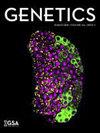分位数特异性混淆:通过分位数回归对细微人群分层进行校正。
IF 5.1
3区 生物学
Q2 GENETICS & HEREDITY
引用次数: 0
摘要
在全基因组关联研究中,微妙的群体结构仍然是一个重要的问题。以人类身高为例,我们展示了分位数回归是线性回归的自然延伸,由于其固有的调节协变量(如主成分)的分位数特定效应的能力,可以更好地校正微妙的人口结构。我们利用英国生物银行和撒丁岛/ProgeNIA项目的数据进行演示。本文章由计算机程序翻译,如有差异,请以英文原文为准。
Quantile-specific confounding: correction for subtle population stratification via quantile regression.
Subtle population structure remains a significant concern in genome-wide association studies. Using human height as an example, we show how quantile regression, a natural extension of linear regression, can better correct for subtle population structure due to its inherent ability to adjust for quantile-specific effects of covariates such as principal components. We utilize data from the UK Biobank and the SardiNIA/ProgeNIA project for demonstration.
求助全文
通过发布文献求助,成功后即可免费获取论文全文。
去求助
来源期刊

Genetics
GENETICS & HEREDITY-
CiteScore
6.90
自引率
6.10%
发文量
177
审稿时长
1.5 months
期刊介绍:
GENETICS is published by the Genetics Society of America, a scholarly society that seeks to deepen our understanding of the living world by advancing our understanding of genetics. Since 1916, GENETICS has published high-quality, original research presenting novel findings bearing on genetics and genomics. The journal publishes empirical studies of organisms ranging from microbes to humans, as well as theoretical work.
While it has an illustrious history, GENETICS has changed along with the communities it serves: it is not your mentor''s journal.
The editors make decisions quickly – in around 30 days – without sacrificing the excellence and scholarship for which the journal has long been known. GENETICS is a peer reviewed, peer-edited journal, with an international reach and increasing visibility and impact. All editorial decisions are made through collaboration of at least two editors who are practicing scientists.
GENETICS is constantly innovating: expanded types of content include Reviews, Commentary (current issues of interest to geneticists), Perspectives (historical), Primers (to introduce primary literature into the classroom), Toolbox Reviews, plus YeastBook, FlyBook, and WormBook (coming spring 2016). For particularly time-sensitive results, we publish Communications. As part of our mission to serve our communities, we''ve published thematic collections, including Genomic Selection, Multiparental Populations, Mouse Collaborative Cross, and the Genetics of Sex.
 求助内容:
求助内容: 应助结果提醒方式:
应助结果提醒方式:


